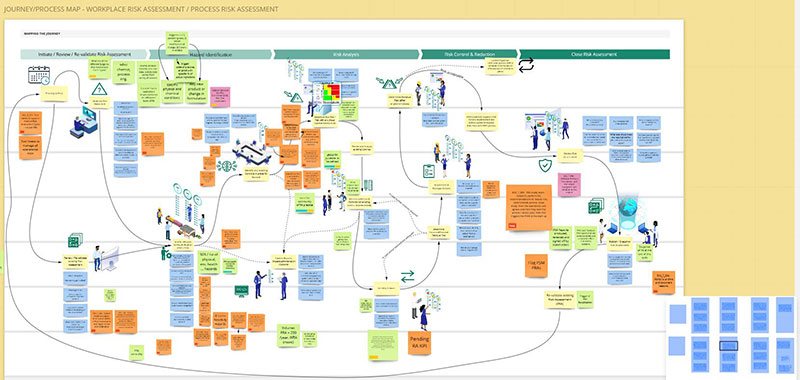


The performance of environmental, health, safety and sustainability (EHS&S) has hit a plateau - and it’s putting more than just revenues and reputations at risk. From reducing the number of workplace accidents to meeting carbon ambitions, organizations need to keep pushing their performance boundaries to meet growing stakeholder expectations.
And that means they need to take their performance improvement efforts to the next level by investing in new technologies, embracing new approaches, and unlocking new insights. To innovate at speed and scale, organizations should expand the approaches they use for defining and delivering EHS&S initiatives and improvements.
Design thinking can act as a catalyst for change, providing a more collaborative and adaptive framework for managing EHS&S projects and programs. Design thinking doesn’t just introduce new processes but also a new mindset, which puts people at the heart of the development cycle. From empathizing with participants and focusing on their pain points, to creating ideas and prototyping solutions, design thinking is focused on experiences and outcomes.
Design thinking is a human-centered approach to innovation that draws from the designer’s toolkit to integrate the needs of people, the possibilities of technology, and the requirements for business success.

Due to its collaborative and iterative approach, design thinking is much more fluid than other development and project management frameworks. As such, the key phases may be executed in any order, occur in parallel, or even be repeated multiple times.
As well as helping organizations address existing challenges relating to safety performance, sustainability and compliance, design thinking can simplify the adoption of new technologies, such as wearables and drones, and identify new ways to leverage mature technologies, such as virtual or augmented reality. As digitalization reaches a tipping point in EHS&S, design thinking can help to match the right technologies to the right use cases and ensure the human factor is not forgotten. In addition, we’re seeing this helping clients realize the following benefits:
Despite such flexibility, design thinking projects all have one thing in common: velocity. When organizations apply more traditional methodologies, it can take between 12 and 18 months for an EHS&S project to result in a workable solution. A lot of people could be impacted during that time: every year 317 million people have some form of accident in the workplace.
Working on multiple programs and projects with our clients we have seen that by transforming the approach used for defining and delivering EHS&S projects, organizations can significantly reduce their time to market - especially when teams focus on delivering a minimal viable product (MVP) rather than the perfect end-to-end solution.
The ability to deliver a workable solution is reliant on understanding the people, the challenges and the opportunities involved. Design thinking makes it easier for project teams to identify the pain points - whether it involves challenges with improving road safety, or identifying more accurate ways to quantify carbon emissions. By observing and discussing how people perform common tasks, problems can be surfaced and clarified to focus on the most significant challenges.
Despite the advances in digital technologies and their growing use in the EHS&S space, many processes still involve some form of human interaction. Improving performance is therefore intrinsically linked to people’s behaviours and attitudes. It is vital to observe the people involved in whatever process trying to be improved, understand the AEIOUs (activities, environments, interactions, objects, and users) and appreciate their pains and challenges. The nature of a human centered, design thinking approach allows you to better emphathize with your stakeholders.
Empathizing with people is just the beginning; design thinking promotes greater engagement and collaboration throughout the process. Using a ‘crowd-sourcing’ or ideation approach to seek input and suggestions from many people provides greater insight into a problem and different ideas for a solution.
Converging on the best ideas also enhances the engagement process. Using hackathons, or a “Shark Tank” approach to pitch different ideas can help progress the most desirable ideas into prototypes. Encouraging colleagues or customers to test their prototypes earlier will enable organizations to incorporate feedback and understand if users’ pain points have really been addressed.
By establishing a continuous feedback loop, solutions can be adapted and improved on a regular basis - even after go-live - to ensure an optimum experience for colleagues and customers and maximum value for the organization.
Although design thinking represents a big change in the development and delivery of EHS&S solutions, it can become a reality with minimal effort and planning. Traditional approaches focus on capturing detailed requirements upfront, which takes time and energy and may not address the real pain points. Design thinking enables a step change by focusing on the most compelling problems faced by different users, iterating to likely solutions and delivering value quickly. Through this human-centric approach, project teams can validate which requirements are the most critical and design a solution that will address the problems.
Design thinking moves quickly, often introducing radically different ways of working and organizations and their people need to prepare to embed new solutions into their day-to-day operations and workflows. Effective organizational change management is essential when adopting design thinking to ensure that the new solutions result in a positive disruption. Lack of effective change management can result in a workforce that is disengaged and resistant to the new technologies and insights that are intended to keep people safe.
Design thinking has already been used to great effect by a number of digital disruptors. For example, Spotify leveraging design thinking to build trust in the age of machine learning. At ERM, design thinking practitioners are harnessing these techniques to tackle strategic problems, such as with one client, prioritizing the right business initiatives within a five-year digital EHS&S roadmap, as well as specific challenges, namely helping field operators report hazards or incidents with greater accuracy and speed. Design thinking and the focus on people and values has allowed our consultants to ensure the deployment of a new EHS platform or testing a proof of concept of using real-time sensor data for predictive analytics is aimed at specific problems in a client and it not just being another digital project.
 ERM supporting the development of user journeys and process maps during a virtual design thinking workshop.
ERM supporting the development of user journeys and process maps during a virtual design thinking workshop.
As an example, we also recently partnered with a leading biotechnology company who was looking to select and deploy a new enterprise EHS platform to better manage risk and to improve getting the right information to frontline operators. We supported this client by immersing participants, representing different functions (e.g, maintenance, operations, EHS, management), different geographies, and different asset types (e.g., large integrated facilities, small sites, headquarters) into a design thinking workshop to identify the requirements of the solution.
Participants identified different problems facing the business, assessed those problems from different viewpoints, and then crystalized those problems into the critical requirements that the new solution needed to address. By emphasizing the human-centric approach, the team were able to discard requirements that sounded important but on further analysis would not really help the workforce. This human-centric approach allowed the diverse global team to quickly align on a set of simple but important requirements for the new solution.
Design thinking enables organizations to succeed faster - and fail smarter - with new EHS&S ideas and solutions, saving both time and money. By encouraging a human-centric approach, it also increases adoption, which will ultimately lead to better performance and safety outcomes for individuals as well as entire organizations and industries.
With remote working becoming the new normal globally in response to COVID-19, collaborative working can be a casualty. Workshops are switching to virtual events and video conferences and workers are juggling work activities while ensuring their children have the appropriate lesson plan. Design thinking does not have to take a back-burner. Virtual collaboration tools, such as Miro, facilitate the sharing of ideas (virtual Post-It notes included) and apply all the benefits of design thinking across a team of people working remotely.
If your business’s EHS&S performance has plateaued, taking a design thinking approach can be the catalyst for a new phase of improvement – while also delivering wider operational and productivity benefits. Below are a six tips to help kick-start design thinking in your organization.


